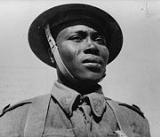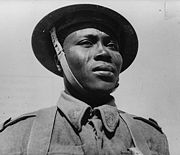
Libyan resistance movement
Encyclopedia
The Libyan resistance movement was the resistance movement
against the Italian
colonization of Libya
.
(Arabic
عمر المختار ‘Umar Al-Mukhtār) (1862 - 16 September 1931), who was from the tribe of Mnifa, born in a small village called Janzour located in the eastern part of Barqa. He was the leader for more than twenty years, from 1912.
Later King Idris and his Senussi
tribe in the provinces of Cyrenaica
and Tripolitania
started to become opposed to the Italian colonization after 1929, when Italy changed its political promises of moderate "protectorate" to the Senussi (done in 1911) and - because of Benito Mussolini
- started to take complete colonial control of Libya.
Resistance was totally crushed by General Rodolfo Graziani
in the 1930s and the country was fully controlled by the Italians with the help of Arab
fascists, to the point that many Libyan colonial troops fought on the side of Italy between 1940 and 1943: two divisions of Libyan colonial troops were created in the late 1930s and 30000 native Libyans fought for Italy during World War II
.
In 1940 the Libyans in the coastal areas were granted Italian citizenship as part of the fascist efforts to create the Greater Italia in Tripolitania and Cyrenaica. This reduced the appeal of the Libyan resistance movement to a few Arab/Berbers populations of the Fezzan
area only, but this was practically non-existent until the arrival of French troops in the area in 1942. At the close of World War II
the British
and French
collaborated with the new resistance to crush Italian forces in Libya as well destroying Italy which brought humiliation and hatred to the country. France and the United Kingdom decided to make King Idris the Emir
of an independent Libya in 1951.

's tribe crushed an Italian garrison in the south of Fezzan, near the border with Chad
, which is implausible, since the tribe were in fact operating on the Tripolitania
/Fezzan border throughout the war. The Fezzan was occupied by the Free French in 1943.
Resistance movement
A resistance movement is a group or collection of individual groups, dedicated to opposing an invader in an occupied country or the government of a sovereign state. It may seek to achieve its objects through either the use of nonviolent resistance or the use of armed force...
against the Italian
Kingdom of Italy (1861–1946)
The Kingdom of Italy was a state forged in 1861 by the unification of Italy under the influence of the Kingdom of Sardinia, which was its legal predecessor state...
colonization of Libya
Libya
Libya is an African country in the Maghreb region of North Africa bordered by the Mediterranean Sea to the north, Egypt to the east, Sudan to the southeast, Chad and Niger to the south, and Algeria and Tunisia to the west....
.
History
It was initially led by Omar MukhtarOmar Mukhtar
Omar Mukhtar , of the Mnifa, was born in the small village of Janzour, near Tobruk in eastern Barqa in Libya. Beginning in 1912, he organized and, for nearly twenty years, led native resistance to Italian colonization of Libya. The Italians captured and hanged him in 1931...
(Arabic
Arabic language
Arabic is a name applied to the descendants of the Classical Arabic language of the 6th century AD, used most prominently in the Quran, the Islamic Holy Book...
عمر المختار ‘Umar Al-Mukhtār) (1862 - 16 September 1931), who was from the tribe of Mnifa, born in a small village called Janzour located in the eastern part of Barqa. He was the leader for more than twenty years, from 1912.
Later King Idris and his Senussi
Senussi
The Senussi or Sanussi refers to a Muslim political-religious order in Libya and the Sudan region founded in Mecca in 1837 by the Grand Senussi, Sayyid Muhammad ibn Ali as-Senussi. Senussi was concerned with both the decline of Islamic thought and spirituality and the weakening of Muslim political...
tribe in the provinces of Cyrenaica
Cyrenaica
Cyrenaica is the eastern coastal region of Libya.Also known as Pentapolis in antiquity, it was part of the Creta et Cyrenaica province during the Roman period, later divided in Libia Pentapolis and Libia Sicca...
and Tripolitania
Tripolitania
Tripolitania or Tripolitana is a historic region and former province of Libya.Tripolitania was a separate Italian colony from 1927 to 1934...
started to become opposed to the Italian colonization after 1929, when Italy changed its political promises of moderate "protectorate" to the Senussi (done in 1911) and - because of Benito Mussolini
Benito Mussolini
Benito Amilcare Andrea Mussolini was an Italian politician who led the National Fascist Party and is credited with being one of the key figures in the creation of Fascism....
- started to take complete colonial control of Libya.
Resistance was totally crushed by General Rodolfo Graziani
Rodolfo Graziani
Rodolfo Graziani, 1st Marquis of Neghelli , was an officer in the Italian Regio Esercito who led military expeditions in Africa before and during World War II.-Rise to prominence:...
in the 1930s and the country was fully controlled by the Italians with the help of Arab
Arab
Arab people, also known as Arabs , are a panethnicity primarily living in the Arab world, which is located in Western Asia and North Africa. They are identified as such on one or more of genealogical, linguistic, or cultural grounds, with tribal affiliations, and intra-tribal relationships playing...
fascists, to the point that many Libyan colonial troops fought on the side of Italy between 1940 and 1943: two divisions of Libyan colonial troops were created in the late 1930s and 30000 native Libyans fought for Italy during World War II
World War II
World War II, or the Second World War , was a global conflict lasting from 1939 to 1945, involving most of the world's nations—including all of the great powers—eventually forming two opposing military alliances: the Allies and the Axis...
.
In 1940 the Libyans in the coastal areas were granted Italian citizenship as part of the fascist efforts to create the Greater Italia in Tripolitania and Cyrenaica. This reduced the appeal of the Libyan resistance movement to a few Arab/Berbers populations of the Fezzan
Fezzan
Fezzan is a south western region of modern Libya. It is largely desert but broken by mountains, uplands, and dry river valleys in the north, where oases enable ancient towns and villages to survive deep in the otherwise inhospitable Sahara.-Name:...
area only, but this was practically non-existent until the arrival of French troops in the area in 1942. At the close of World War II
World War II
World War II, or the Second World War , was a global conflict lasting from 1939 to 1945, involving most of the world's nations—including all of the great powers—eventually forming two opposing military alliances: the Allies and the Axis...
the British
United Kingdom
The United Kingdom of Great Britain and Northern IrelandIn the United Kingdom and Dependencies, other languages have been officially recognised as legitimate autochthonous languages under the European Charter for Regional or Minority Languages...
and French
France
The French Republic , The French Republic , The French Republic , (commonly known as France , is a unitary semi-presidential republic in Western Europe with several overseas territories and islands located on other continents and in the Indian, Pacific, and Atlantic oceans. Metropolitan France...
collaborated with the new resistance to crush Italian forces in Libya as well destroying Italy which brought humiliation and hatred to the country. France and the United Kingdom decided to make King Idris the Emir
Emir
Emir , meaning "commander", "general", or "prince"; also transliterated as Amir, Aamir or Ameer) is a title of high office, used throughout the Muslim world...
of an independent Libya in 1951.

Anecdote
A widely held story was that Colonel Muammar GaddafiMuammar Gaddafi
Muammar Muhammad Abu Minyar Gaddafi or "September 1942" 20 October 2011), commonly known as Muammar Gaddafi or Colonel Gaddafi, was the official ruler of the Libyan Arab Republic from 1969 to 1977 and then the "Brother Leader" of the Libyan Arab Jamahiriya from 1977 to 2011.He seized power in a...
's tribe crushed an Italian garrison in the south of Fezzan, near the border with Chad
Chad
Chad , officially known as the Republic of Chad, is a landlocked country in Central Africa. It is bordered by Libya to the north, Sudan to the east, the Central African Republic to the south, Cameroon and Nigeria to the southwest, and Niger to the west...
, which is implausible, since the tribe were in fact operating on the Tripolitania
Tripolitania
Tripolitania or Tripolitana is a historic region and former province of Libya.Tripolitania was a separate Italian colony from 1927 to 1934...
/Fezzan border throughout the war. The Fezzan was occupied by the Free French in 1943.
See also
- Italy's 'Fourth Shore'
- World War IIWorld War IIWorld War II, or the Second World War , was a global conflict lasting from 1939 to 1945, involving most of the world's nations—including all of the great powers—eventually forming two opposing military alliances: the Allies and the Axis...
- The concept of Italia irredentaItalia irredentaItalian irredentism was an Italian Irredentist movement that aimed at the unification of all ethnically Italian peoples....
- The Italian Mare Nostrum
- Greater Italia
External links
- http://countrystudies.us/libya/20.htm
- http://www.workmall.com/wfb2001/libya/libya_history_world_war_ii_and_independence.html
- http://www.archive.org/search.php?query=collection%3A%22opensource_movies%22%20AND%20(subject%3A%22%20World%20War%20II%22)
- http://countrystudies.us/libya/23.htm

